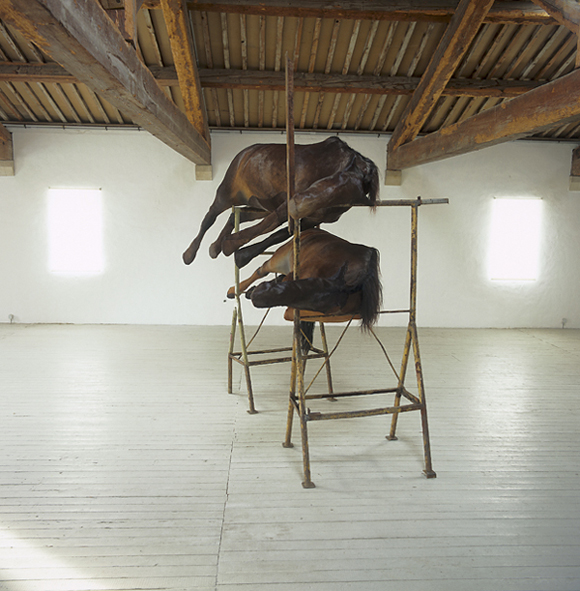Currently on view: Montréal
Berlinde De Bruyckere
at DHC/ART, Montréal
30 June – 13 November 2011

“Les Deux” (2007) Courtesy Galleria Continua, San Gimignano / Beijing / Le Moulin
The air is somber and solemn at DHC/ART gallery, where life-size sculptures of human and equestrian carcasses are lugubriously arranged in a clinically white exhibition. An unsettling sense of disquiet has taken over the space, as if we have just witnessed the inexorable reality of a public execution. Belgian artist Berlinde De Bruyckere uses the physical body as a vessel, a receptacle to endure violence, pain, suffering and ultimately death, the body as a theater that lays bare the trials of our human condition.
“Les Deux” (2001) displaces the gallery into a veterinary morgue, in laying out two sculptures of full-grown horses on a purpose-built scaffold. These ostensibly simulate real animals, such that one expects the stench of fresh road-kill to arise. Not quite real, however these were cast from actual corpses and subsequently covered with genuine hides and manes, hand stitched together. The equine faces are featureless, eyes, nostrils and mouth have been sown shut, to accentuate our perception of an enormous lifeless mass. Throughout the ages, horses have symbolized power, glory, strength and freedom, the noble beast long ago domesticated by humans has served in as many campaigns for civilization, as for pillage and war. Now channeled through De Bruyckere’s vision, the horse has become an emblem for the aftermath of powerlessness and desolation.

(left) “Invisible beauty & Invisible Love I’ (2011); (right) “Invisible beauty & Invisible Love II” (2011) Courtesy DHC/ART. Photo: Richard-Max Tremblay
As for the two human bodies hung on the walls in crucifixion poses, “Invisible Beauty and Invisible Love I & II†(2011) are meticulously rendered down to subtly bulging veins and rippling muscles, melting onto their supporting metal hangers and leather strips. These are often cast from athletic dancers, from which De Bruyckere adds layers of colored wax to create contrasting textures and subtle flesh contortions. The wax color also informs the skin surface to suggest bruises and abrasions on the helpless emaciated corporeality. Beheaded, detached from the brain where all the senses and movements operate, again these cadavers are unquestionably left for dead. Somehow these mortal frames have retained just enough vitality to hang into position against gravity, and we are kept waiting for their fall, fascinated as in turn we will all face the inevitable.
De Bruyckere’s figures discernibly draw inspiration from Giordano, Cranach and other old masters, in the way corporal bodies are depicted with such power. Works with such historical references affirm their relevance by still succeeding to delve deep into our psyche, thus showing not much has changed of the human condition in the past few centuries.

“20” (2007) Courtesy DHC/ART. Photo: Richard-Max Tremblay
In the gallery’s second room stand two antique vitrines. The first of which, entitled “20†(2007), displays an eerie anthropomorphic figure blurring the line between animal and human anatomy. The hybrid creature could just as well have come out of the imagination of ancient mythology or futurist science fiction. In leaving one of the cabinet doors half open, the artist affirms a potential for this chimera to pounce on us at any second, challenging the safety of our detached observer’s position. The second glass case, “0.28†(2010), presents elaborately detailed tree miniatures. Trees have time and again symbolized life, energy, compassion and wisdom. Yet in removing their roots and branches, the left over trunks are literally cut off from their environment, alienated, and reduced to the status of building material. Folded blankets, piled underneath the trunks perhaps offer a final glimpse of concern and protection for the recently laid to rest plants. If nothing else, the contrasts between violence and preciousness make for an interesting metaphor.

“0.28” (2007) Courtesy Galleria Continua, San Gimignano / Beijing / Le Moulin. Photo by Ela Bialkowska
The show at DHC amply taps into our social consciousness to induce multivalent results. These works reflect our past as much as our present times, too much of which is still accountable for human and environmental exploitation, often on a scale of extreme violence, scarring our personal and collective memory in the process. De Bruyckere polarizes the dichotomies of life and death, terror and empathy, suffering and solace, danger and protection. In doing so she reveals the tragic limits of flesh and blood, and yet also re-affirms the poetic beauty of our ephemeral existence.
DHC/ART
451 & 465 St-Jean
Montréal, QC, H2Y 2R5
Canada
+1 514 849 3742
info@dhc-art.org
www.dhc-art.org
